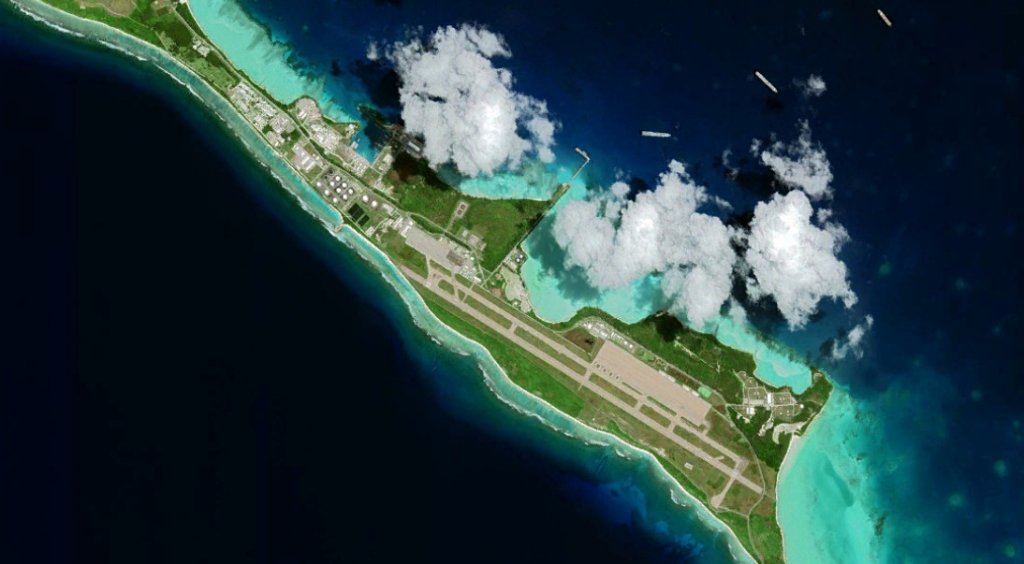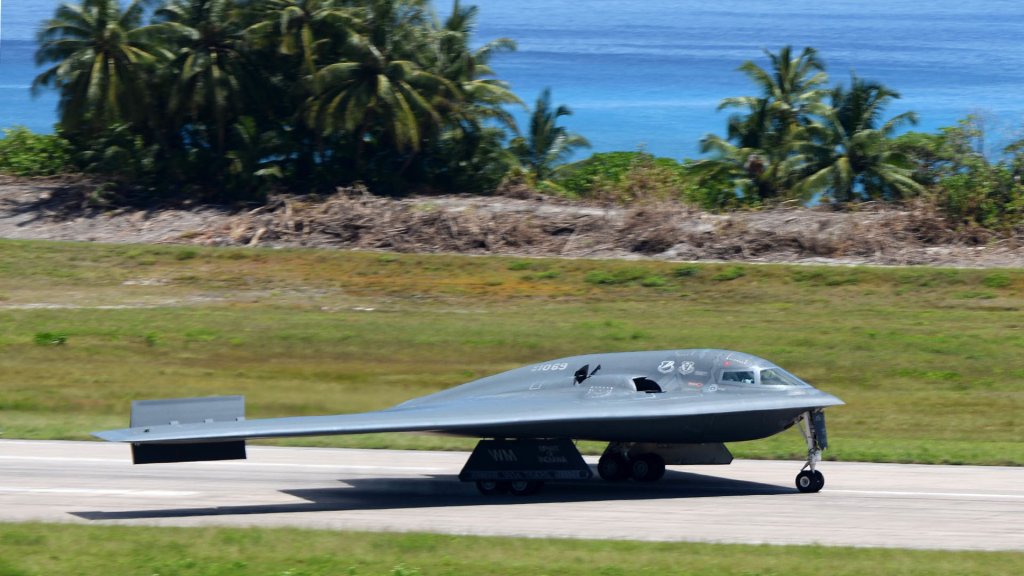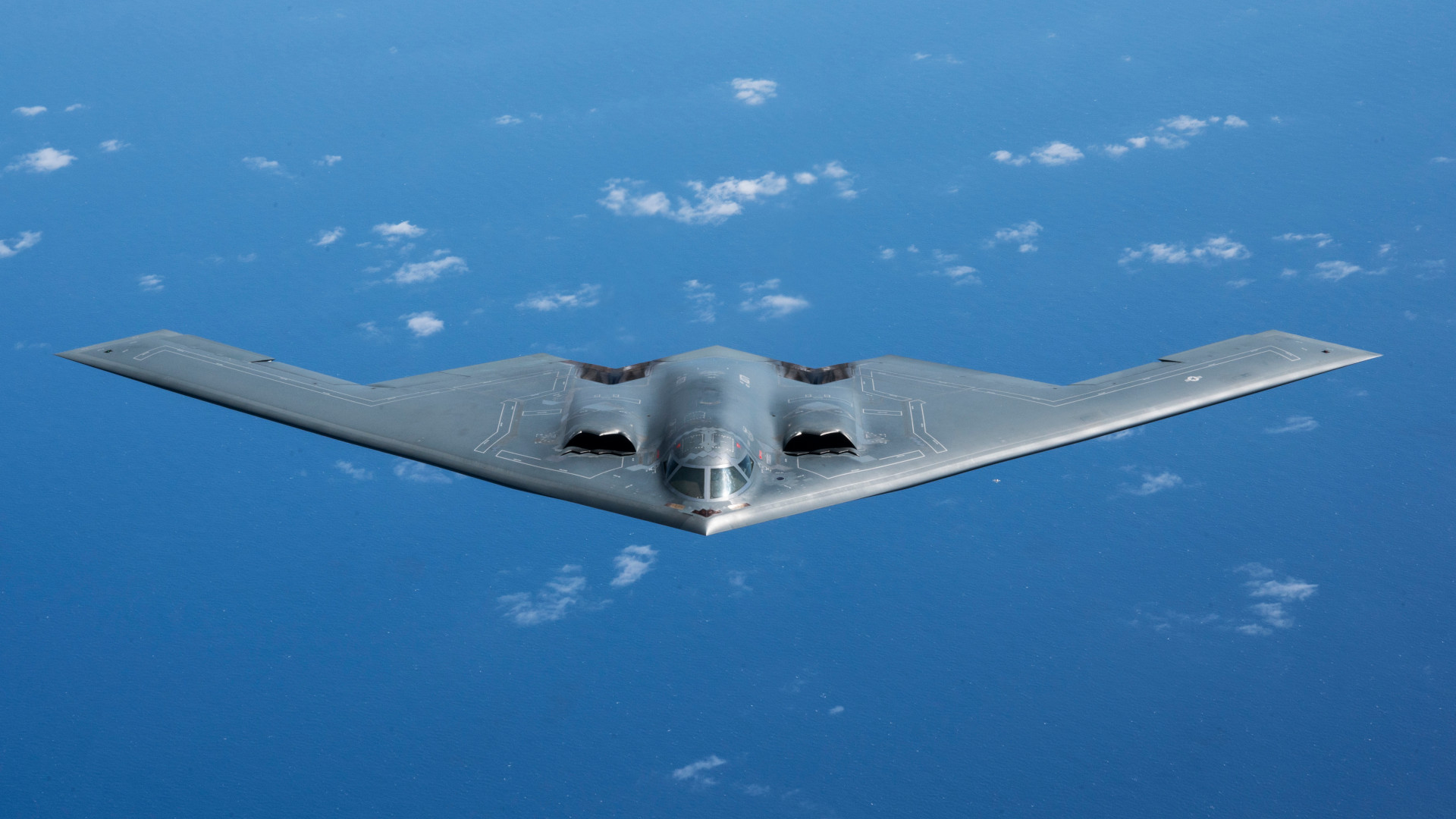A significant force of B-2 Spirit stealth bombers looks to be currently wending its way to the Indian Ocean island of Diego Garcia. Satellite imagery shows at least three C-17 cargo planes and 10 aerial refueling tankers forward-deployed in the last 48 hours to the highly strategic British territory, which has been used as a staging point for U.S. strikes in the Middle East on multiple occasions in the past. The build-up comes amid a new surge in U.S. strikes targeting the Houthis and growing warnings to Iran from the Trump administration over support for the Yemeni militants and Tehran’s nuclear ambitions.
The crews of two B-2 bombers, callsigns Pitch 11 and Pitch 14, could be heard communicating with air traffic controllers in Australia earlier today in publicly available audio. The crew of Pitch 11 confirms the presence of a third bomber, as well. The trio of bombers appears to have refueled in flight over Australia while heading westward.
A fourth B-2, callsign Pitch 13, landed at Hickam Air Force Base in Hawaii yesterday after declaring an emergency in flight. Video subsequently emerged showing that aircraft being met on the ground by a crash truck, but the nature of the emergency remains unknown.
Additional air traffic control recordings indicate that additional B-2s, using the callsign Abba, departed Whiteman Air Force Base in Missouri earlier today also bound for Diego Garcia. The Air Force’s entire force of 20 B-2 bombers is based at Whiteman.
“A B-2 Spirit bomber arrived at Hickam Air Force Base,” Air Force Global Strike Command (AFGSC) told TWZ today in response to questions about the in-flight emergency and recent B-2 movements in the Indo-Pacific region more broadly.
“U.S. Strategic Command, its components, and subordinate units routinely conduct global operations in coordination with other combatant commands, services, and participating U.S. government agencies to deter, detect and, if necessary, defeat strategic attacks against the United States and its allies,” AFGSC added. “To preserve operational security, we do not discuss details about exercises or operations.”

Major movements of C-17s and tankers to the Indian Ocean island, as well as to Hickam in Hawaii and Andersen Air Force Base in Guam, look to have started last week, according to online flight tracking data and information from the international Aircraft Communications Addressing and Reporting System (ACARS).
Separately, Politico reported last week that Secretary of Defense Pete Hegseth had extended the U.S. Navy aircraft carrier USS Harry S. Truman‘s current Middle Eastern deployment and directed another carrier strike group, led by the USS Carl Vinson, to join it in the region. Online flight tracking data and air traffic control recordings have pointed to a recent deployment of Air Force F-35A Joint Strike Fighters to the Middle East, as well.
Overall, what has been observed so far with regard to Diego Garcia represents a force package that is significantly larger than what has typically been associated with routine Bomber Task Force deployments globally, as well as exercises, in recent years.
A deployment of just four B-2s, representing 20 percent of the Air Force’s total fleet of the stealth bombers, to Australia in 2022 was seen as sending a significant signal to China and other potential adversaries, as well as to America’s allies and partners across the Indo-Pacific region. Two years earlier, six B-52s went to Diego Garcia in another show of force in the wake of the U.S. military killing Qasem Soleimani, then head of the Quds Force external operations arm of Iran’s Islamic Revolutionary Guard Corps, in neighboring Iraq.
The Indian Ocean island was notably used as a primary launchpad for bomber strikes in the opening phases of Operation Enduring Freedom in Afghanistan in 2001 and Operation Iraqi Freedom in that country in 2003. Bombers continued to fly combat missions from the Indian Ocean base for some time afterward.
It is very important to note here that Diego Garcia, unlike bases in the Middle East or aircraft carriers operating in the region, is largely out of the reach of the missiles and drones available now to either the Houthis or Iran. Iran’s current longest-range ballistic missiles are generally assessed to have maximum ranges around 1,242 miles (2,000 kilometers). At its shortest, the distance between the Indian Ocean island and Iran is some 2,358 miles (3,795 kilometers).
Diego Garcia’s general location relative to various potential hotspots only adds to its strategic significance. The island’s lagoon is also used to host a U.S. Military Sealift Command Prepositioning Ship Squadron full of military vehicles, ammunition, and other materiel for rapid deployment in the event of any of a host of contingencies.

Staging more than four B-2s at Diego Garcia now would be at least another major show of force aimed squarely at the Middle East. The bombers present a unique mix of capabilities, particularly their ability to penetrate past dense enemy air defenses to carry out ‘bunker buster’ strikes employing 30,000-pound class GBU-57/B Massive Ordnance Penetrator (MOP) bombs. MOP, which only the B-2 is currently certified to employ operationally, itself offers a unique conventional option for striking deeply buried and fortified targets, of which there are many in Iran.
B-2 bombers were also used just last October for strikes against the Houthis in Yemen, which also sent a clear message to the group’s benefactors in Tehran, as TWZ highlighted at the time. The Houthis have been waging a campaign against commercial shipping in and around the Red Sea, as well as targeting foreign military forces in the region and launching attacks on Israel, for more than a year now. This has been ostensibly in retaliation for Israeli operations in Gaza following the brazen Hamas terrorist attacks on Oct. 7, 2023.
“The Biden Administration sat back as a band of pirates – with precision-guided, Iran-provided weaponry – exacted a toll system in one of the most important shipping lanes in the world,” President Donald Trump’s White House declared in a statement just today. “The Trump Administration’s actions to hold the Houthis accountable has been a massive success – and nothing can distract from that unrelenting action to keep Americans safe.”
This follows widespread outcry over The Atlantic‘s now confirmed disclosure that its editor-in-chief Jeffrey Goldberg was apparently inadvertently included in a group chat on Signal, an encrypted messaging app, in which top members of the Trump administration discussed imminent strikes on the Houthis earlier this month.
“Any further attack or retaliation by the ‘Houthis’ will be met with great force, and there is no guarantee that that force will stop there,” Trump had also written in a post on his Truth Social social media network back on March 17. “They’re [Iran] dictating every move, giving them the weapons, supplying them with money and highly sophisticated Military equipment, and even, so-called, ‘Intelligence.’ Every shot fired by the Houthis will be looked upon, from this point forward, as being a shot fired from the weapons and leadership of IRAN, and IRAN will be held responsible, and suffer the consequences, and those consequences will be dire!”
“Freedom of navigation is basic; it’s a core national interest,” Hegseth said on March 15. “The minute the Houthis say, ‘We’ll stop shooting at your ships [and] we’ll stop shooting at your drones,’ this campaign will end but, until then, it will be unrelenting.”
“The message is clear to Iran,” Hegseth added at that time. “Your support of the Houthis needs to end immediately. We will hold you accountable as the sponsor of this proxy, and I echo [the president’s] statement [that] we will not be nice about it.”
Iran’s support for the Houthis is substantial and indisputable, but experts disagree on the extent to which Tehran can directly dictate the group’s activities. The U.S. government also assesses that Yemeni militants have, with Iran’s help, been able to establish a significant capacity to produce ballistic and cruise missiles, as well as long-range kamikaze drones domestically, as you can read more about here.
“We do think that they do a lot of production in-house,” a senior U.S. defense official told TWZ during a media engagement on the sidelines of the Air & Space Forces Association’s 2025 Air Warfare Symposium earlier this month. “Our assessment right now is that there’s likely some key components and other things that come from Iran or other places, but a lot of the actual production is in Yemen.”

Since taking office in January, Trump has also said he is pursuing a new deal with Iran over its nuclear ambitions, as well as its long missile programs, despite withdrawing from a previous agreement with Tehran in his first administration. Axois reported last week that a letter the President recently sent to Iranian Supreme Leader Ali Khamenei via the United Arab Emirates included a two-month deadline for coming to a new arrangement, which could come up as soon as the first week of May. The new Trump administration has otherwise implied threats of potential military action if Iran doesn’t agree to give up its ability to produce nuclear weapons, as well.
“We don’t need to solve everything militarily,” Steve Witkoff, U.S. special envoy to the Middle East, told Fox News this weekend. “Our signal to Iran is let’s sit down and see if we can, through dialogue, through diplomacy, get to the right place. If we can, we are prepared to do that. And if we can’t, the alternative is not a great alternative.”
“Iran has to give up its program in a way that the entire world can see,” Mike Waltz, Trump’s National Security Advisor, said during a separate interview on CBS News‘ “Face the Nation” this weekend. “It is time for Iran to walk away completely from its desire to have a nuclear weapon, and they will not and cannot be allowed to have a nuclear weapons program. That is its weaponization and its strategic missiles program.”
The Wall Street Journal reported in December that Trump’s transition team was already reviewing options for possible strikes and other actions targeting Iran’s nuclear program. In its latest unclassified global threat assessment report released today, the U.S. Intelligence Community reiterates its long-standing view that Iran does not have an active nuclear weapons program, but warns pressure is growing on Supreme Leader Khamenei to change course.
All this being said, there are no clear indications as yet that the Trump administration is actively considering imminent direct action against Iran. Even with the regime in Tehran and its regional proxies at their weakest points in decades after various actions by the Israeli government in the past year or so, there is the potential for serious blowback from any U.S. strikes on Iranian targets.
In the meantime, what is at least a major show of force that looks set to include a significant portion of the Air Force’s B-2 fleet, along with various supporting assets, is taking shape on Diego Garcia in the Indian Ocean.
Update: 3/26/2025 –
Satellite imagery from Planet Labs now confirms that at least three B-2s have arrived at Diego Garcia. Also visible in the image in question, which was taken earlier today, are seven KC-135 tankers, a C-17 cargo plane, and what may be a P-8A Poseidon maritime patrol aircraft. Whether or not more of the bombers are parked inside shelters is unknown. This also provides another data point in the ongoing debate about whether or not the U.S. military should be investing in more aircraft shelters, hardened and not, at key air bases, especially in the Indo-Pacific region, something TWZ has been covering closely.
Two new Notice to Air Mission (NOTAM) warning notices are also in place for Diego Garcia, one reflecting the reserving of certain parking spots (which is currently scheduled to be in effect until May 1) and another temporarily closing a number of taxiways (which is presently set to be in place through April 27). The closure of the taxiways may be linked to the large number of aircraft now parked on the main apron.
Earlier today, White House Deputy Chief of Staff Dan Scavino posted an old video of a B-2 bomber in flight on his personal account on X (but also shared it through his official account on the social media network) with no clear context. Whether or not this is related in any way to the current flow of airpower to Diego Garcia is unknown.
Contact the author: joe@twz.com
